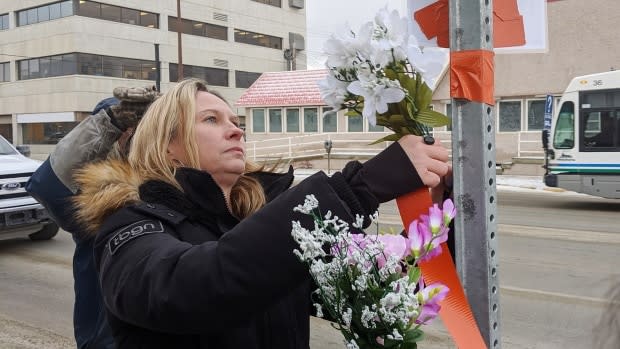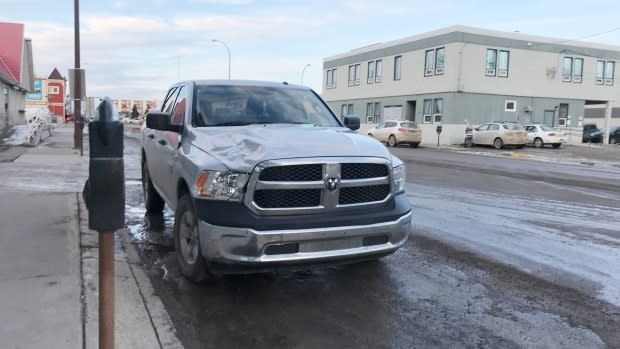In wake of deaths, is it time to rethink Whitehorse's Second Avenue?
It's no secret that Second Avenue in Whitehorse is dangerous.
That goes for drivers, cyclists and pedestrians alike. But drivers are ensconced in big metal boxes, posing a bigger threat to other road users than vice versa.
The danger was underscored late last month when 48-year-old cab driver Merle Gorgichuk died after being struck by a pickup truck while he was in a crosswalk at Second Avenue and Elliot Street.
On Thursday, Gorgichuk's friends gathered to put up a makeshift memorial at the intersection.
"This is where he was hit," said Adam Desbarres. "This was the spot. I wanted to see them put up flowers and show that we all care about him."
"He was an awesome guy, man. He would give the shirt right off his back. He went out of his way to be good to people."
Kerry Nolan helped organize the memorial.
"He was not just our friend, our safe taxi driver," she said. "He was part of our community."
Nolan said she's angry nobody has yet been charged in connection with Gorgichuk's death. RCMP said Friday they're still investigating.

Friend Marty Erickson said there should be more crossing lights for pedestrians along Second Avenue.
"People fly down here, man," Erickson said, gesturing to the street. "They don't just travel. They fly."
Deadly street
There have been several deaths on Second Avenue over the years.
In 2016, 71-year-old Margaret Johnson died when she was struck by a pickup truck. The coroner found Johnson had piloted her electric wheelchair northbound into a southbound lane to get around an uncleared sidewalk.
Investigators determined the driver of the truck wasn't speeding. No charges were ever laid in that case.
And the intersection at Second and Elliott has been the scene of collisions before. In 2001, 85-year-old Margaret Wood died after being hit in the crosswalk.
This week, Wood's family told the Yukon News the city needs to reduce speed limits on Second. And they pleaded with drivers to slow down.
"Everyone's in a rush, and for what?" great-granddaughter Michelle Leas told the News' Jackie Hong. "After so many people have been hit, some action needs to be taken at some point here. I mean, this can't keep happening."

Calls for action
There are signs of movement on the issue at Whitehorse city council.
Earlier this week, Coun. Laura Cabott raised the issue of reducing speed limits. Cabott said Second Avenue's use as a high-speed thoroughfare is "incompatible" with downtown's status as a walkable shopping district.
"Immediate action is something that the public is looking for and has been looking for for a while," Cabott said.
Coun. Steve Roddick said the city should looking at more sweeping changes to the design of Second Avenue to slow down traffic.
So-called road diets or lane reductions have been used in other cities to make streets better for pedestrians, cyclists, and drivers alike, said Brent Toderian, a Vancouver urban planner.
Toderian said streets in many North American cities have been built to favour the speed and volume of vehicle traffic over the needs of other road users.
"Engineers have tried to take the pedestrian equation out of the driver's thinking, which gives the driver confidence to go faster," he said.
"The counterintuitive thing is that when there is more going on in streets, particularly downtown main streets, people slow down, they pay more attention and it's safer for everyone."
City staff say a corridor study should be completed by the end of the month. A larger master plan for the city's entire transportation network is planned for next year.
Mike Gau, the city's director of development services, said those plans include possible changes to Second Avenue, with upgrades coming as soon as next year.


